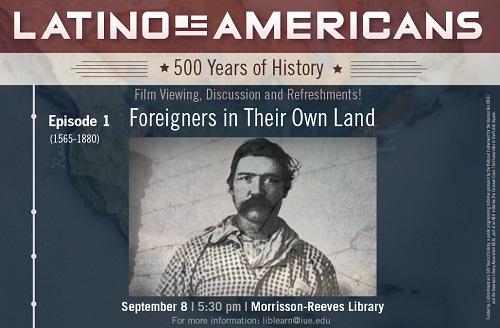Join campus and community members for the first film in the “Latino Americans: 500 years of history” series, on Tues., September 8 at 5:30 pm at the Morrisson-Reeves Library. IU East scholar Dr. Christine Nemcik will lead a discussion about the early history of Latinos in America. Refreshments will be provided by community member Pam Zelaya. There will also be an opportunity for participants to have “cultural conversations” with IU East students, as we strive to document the stories of local members of the Latino American community on our region.
The streaming version of the film, available in English and in Spanish, is available here as well as a lecture by Dr. Nemcik. Below is a summary of this episode. We hope to see you at the live screening! Questions, or for more information, contact fyates@iue.edu
“One hundred years after Columbus’ arrival in the Caribbean, Spanish conquistadors and priests push into North America in search of gold and to spread Catholicism. With the arrival of the British in North America, the two colonial systems produce contrasting societies that come in conflict as Manifest Destiny pushes the U.S into the Mexican territories of the Southwest.
Apolinaria Lorenzana provides a window to the Spanish Mission System while Mariano Vallejo personifies the era of the Californio rancheros, an elite class who thrive after Mexico gains its independence from Spain. Juan Seguín, a third generation Tejano, or Texan, is caught between two worlds; his commitment to an Independent Texas and his identity as a Mexican. Through the Mexican American War, the U.S. takes a full half of Mexico’s territory by 1848. Over 70,000 Mexicans are caught in a strange land, and many become American citizens.
As the Gold Rush floods California with settlers, complex and vital communities are overwhelmed. The elites, including Mariano Vallejo and Apolinaria Lorenzana lose their land. Mexicans and Mexican Americans are treated as second-class citizens, facing discrimination and racial violence. Resistance to this injustice appears in New Mexico as Las Gorras Blancas (The White Caps), burn Anglo ranches and cut through barbed wire to prevent Anglo encroachment. At the same time, New Mexicans manage to transform themselves through education, managing to preserve Hispano culture in New Mexico and their standing in the midst of an era of conquest and dispossession.
Latino Americans: 500 Years of History, a public programming initiative produced by the National Endowment for the Humanities (NEH) & the American Library Association, is part of an NEH initiative, The Common Good: The Humanities in the Public Square


